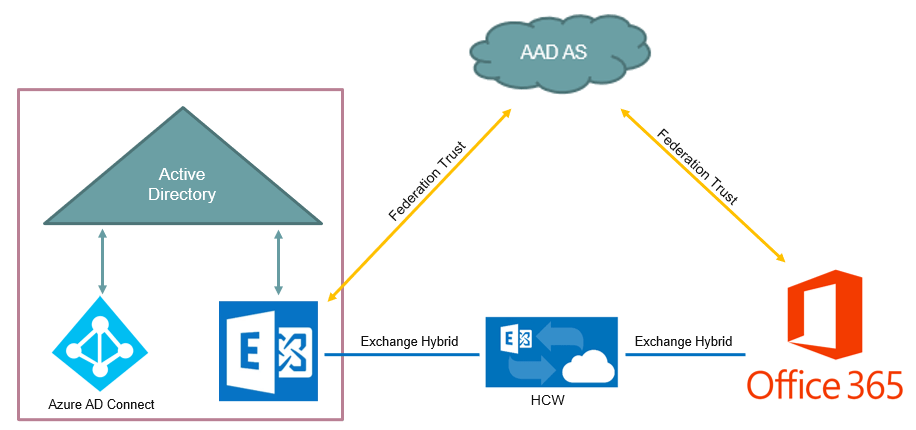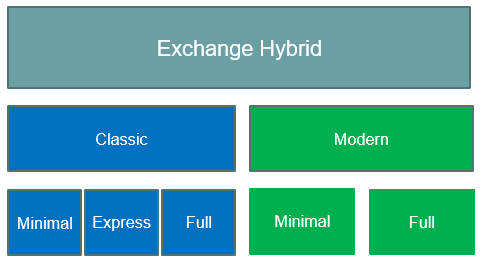What is Exchange Hybrid deployment
In this blog we learn what is Exchange Hybrid deployment, we will talk about Exchange hybrid components, we will talk about benefits of Exchange hybrid deployment, and we will talk about types if Exchange hybrid deployment.
Table of Contents
Watch the video
Watch this video to learn what is Exchange Hybrid deployment, its benefits and components, and the Exchange hybrid deployment types.
What is Exchange hybrid
Exchange Hybrid deployment provides a seamless look and feel of a single Exchange organization between on-premises Exchange server and Exchange Online. In nutshell Exchange Hybrid deployment let’s 2 different organizations to work as a single organization.
Let’s assume we have deployed Exchange server and now we we want to use Microsoft 365 services like, Exchange Online, Microsoft Teams, SharePoint Online and other services those are provided by Microsoft 365 subscription. Exchange Hybrid deployment allows users to use both Exchange on-premises and Microsoft 365 services.
Difference between Exchange Server and Exchange hybrid
Let’s compare some of the services with on-premises Exchange and Exchange hybrid.

Mailbox Location: When you have on-premises Exchange Server, the mailboxes are stored in your on-premises Mailbox server. But when you deploy Exchange hybrid, the mailboxes can be stored either on-premises or in Exchange Online.
Email Flow: When you have only on-premises Exchange Server, email routing is handled only by on-premises Exchange server. But after deploying Exchange hybrid, you can control email routing either from on-premises Exchange or from Exchange online. You can setup centralized or decentralized mail flow and you can control email routing either from on-premises or from Exchange Online.
Outlook on the Web (OWA): In on-premises Exchange server, OWA requests are handled by only on-premises Mailbox server. But post deploying Exchange Hybrid, on-premises and Exchange Online users can use same OWA URL.
Unified GAL: Unified GAL is not available in on-premise Exchange server organization. But after deploying Exchange Hybrid, on-premises users and Exchange Online users will be a part of same Address List. Which is called Unified GAL.
Free Busy sharing: In on-premises Exchange Server, only on-premises users can share free/busy information between each other. But when you have Exchange hybrid deployed, free/busy can be shared between on-premises users and Exchange online users.
Components of Exchange Hybrid architecture
Exchange Hybrid deployment includes 5 components.

- Exchange Server: The first component of Exchange hybrid architecture is Exchange Server. If you want to deploy Exchange Hybrid, you need at least one Exchange server in your environment. If you have Exchange 2016 or 2019, you need at least one Mailbox server. And if you have Exchange 2013 or earlier version, you need at least one Mailbox server and one Client Access Server.
- Microsoft 365 tenant: The second component of Exchange Hybrid deployment is Microsoft 365 tenant. Microsoft 365 is a cloud-based subscription model. This is also called Software as a Service where you use services based on the subscription that you have purchased.
- Azure Active Directory Authentication System: The 3rd component of Exchange Hybrid deployment architecture is Azure Active Directory Authentication System. Earlier this was used to be called Microsoft Federation Gateway. This is a free cloud-based service that acts as a trust broker between on-premises Exchange Server and Exchange online. When you create Microsoft 365 tenant, a trust is automatically created between your tenant and Azure Active Directory Authentication System. But for on-premises Exchange server this trust is not created automatically. This trust is created when you run Hybrid Configuration Wizard or you can create it manually using PowerShell commands.
- Microsoft Entra Connect: The 4th component of Exchange Hybrid deployment is Microsoft Entra Connect (Azure AD Connect). Azure AD Connect is a Microsoft tool that is used to synchronize on-premises identities to Microsoft 365.
- Hybrid Configuration Wizard (HCW): The 5th component of Exchange Hybrid deployment is Hybrid Configuration Wizard or HCW. Hybrid Configuration Wizard provides a streamlined process to configure an Exchange hybrid deployment between on-premises Exchange and Exchange online.
Benefits of Exchange Hybrid deployment
Now Let’s talk about the benefits provided by Exchange Hybrid deployment.
- Shared domain namespace: In Exchange Hybrid deployment on-premises users and Microsoft 365 users can use the same domain namespace for their email addresses. For example, the domain that you are using in on-premises Exchange server, you need to verify and add the same domain in Microsoft 365 as well (this is one of the pre-requisites of Exchange hybrid deployment). That means, on-premises users, migrated users, and cloud-hosted users will use same domain for their email addresses.
- Unified Global Address List: When you deploy Exchange hybrid, Microsoft 365 users and the Exchange server migrated users will be part of a single global address list. That means, cloud hosted users and migrated users will be able to see each other in Exchange Online Global Address List. This is also called Unified Global Address List (Unified GAL).
- Free Busy and calendar sharing: Exchange Hybrid deployment enables Free/Busy and calendar sharing between on-premises and Exchange Online. On-premises users and cloud hosted users can see each other’s availability and they can share calendars with each other.
- Centralized mail flow: By enabling centralized mail flow we can control the inbound and outbound email flow. All external emails will be routed to the MX record, and through the outbound connector those emails will be delivered to the on-premise. And basis on the recipient location emails will be delivered to the mailboxes.
- Secure communication: In Exchange hybrid deployment, emails sent between on-premises and Exchange online organization are sent over TLS. Any email that is sent between on-premises Exchange server and Exchange online is considered as internal email, and the SCL value for these emails will be stamped as -1.
- Onboard and offboard migration: In Exchange Hybrid you can migrate on-premises mailboxes to Exchange online, and you can offboard them back to the on-premises Exchange server.
- Centralized mailbox management: Exchange hybrid deployment enables centralized mailbox management in on-premises Exchange Admin Center. An administrator can manage on-premises mailboxes and migrated mailboxes from on-premises Exchange Admin Center.
- Online-archiving: In Exchange hybrid deployment, on-premises users can take benefit of online-archiving. Administrators can enable online archiving for the mailboxes that exist in on-premises.
- Integrate Microsoft Teams: If you have Exchange server 2019 in on-premises and Exchange hybrid is deployed, on-premises users can use Microsoft Teams. But to achieve this an administrator will have to meet certain prerequisites.
Exchange hybrid deployment types
Now Let’s talk about the different types of Exchange hybrid deployment options available for your on-premises Exchange organization.

Hybrid Configuration Wizard (HCW) currently supports Classic topology and Modern topology. Classic topology includes minimal, express, and full Exchange hybrid. Modern topology includes minimal and full Exchange hybrid deployment.
Important: Exchange Hybrid features availability depends on the type of deployment topology that is selected while running Hybrid Configuration Wizard.
Difference between Exchange Classic Hybrid topology and Exchange Modern Hybrid topology
Now the question arises what type of Exchange hybrid deployment you should choose Classic or Modern. So let’s see what is the difference between Exchange classic hybrid topology and Exchange modern hybrid topology.

Exchange Classic Hybrid topology vs Exchange Modern Hybrid topology.
- In Exchange classic hybrid deployment, Exchange online and on-premises Exchange connect to each other during mailbox migration or for any type of communication. Whereas Exchange modern hybrid deployment installs Hybrid agent that handles all the communication between on-premises and Exchange online organization.
- You can choose Exchange classic topology if you want to configure a permanent hybrid environment. Exchange modern hybrid deployment is the option when you want to migrate mailboxes to Exchange online, and later you want to decommission your on-premises Exchange server.
- You can choose Exchange classic hybrid deployment if you have purchased a 3rd party SSL certificate for SMTP, Autodiscover and other services. Whereas if you do not have a 3rd party SSL certificate, you can choose Exchange modern hybrid deployment. But Hybrid Agent doesn’t handle SMTP mail flow, so you still need an SSL certificate for mail flow between on-premises and Exchange online.
- Exchange classic hybrid deployment includes all features of Exchange hybrid deployment. Whereas Exchange modern hybrid topology includes only free/busy and mailbox migration. Mail flow, multi-mailbox search or cross-premises message tracking is not included in Exchange modern hybrid topology.
Conclusion
In this blog we learnt what is Exchange hybrid deployment, we talked about benefits of Exchange hybrid deployment, we learnt what are the components of Exchange hybrid architecture, we discussed what is the difference between Exchange server and Exchange hybrid, and what is the difference between Exchange classic hybrid topology and Exchange modern hybrid topology.
Found this article helpful and informative, you might like our blogs series on Exchange Server 2019 training. Please share this article within your community and do not forget to share your feedback in the comments below. Join us on our YouTube channel for the latest videos on the Cloud technology and join our Newsletter for the early access of the blogs and updates.
Happy Learning!!
